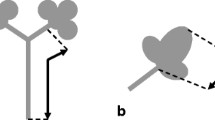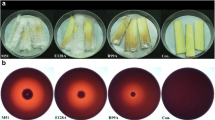Abstract
A pH tolerant strain of Fusarium moniliforme NCIM1276 with a saprophytic mode of nutrition was isolated from a coastal estuarine environment. Under laboratory conditions, the fungus produced significant biomass between pH 3 and 9, and produced cell wall degrading enzymes such as pectinases (polygalacturonase and pectate lyase), carboxymethylcellulase, xylanase and amylase. The production of these enzymes by the isolate in liquid medium, semi-solid medium and in infected tomato and cauliflower plants tissue was investigated. In liquid medium, the production of cell wall-degrading enzymes was induced by appropriate substrates, whereas the organism secreted all enzymes constitutively on wheat bran. The production of polygalacturonase, pectate lyase, carboxymethylcellulase, xylanase and amylase was increased by 3, 2, 11, 10 and 4-fold respectively on semi-solid medium containing wheat bran and orange pulp. Moreover when the fungus was allowed to infect tomato and cauliflower plants, the fungus was localized in the cortical tissues of the plants and secreted pectinases, carboxymethylcellulase and xylanase enzymes in the infected host tissue.





Similar content being viewed by others
Abbreviations
- PG:
-
Polygalacturonase
- PL:
-
Pectate lyase
- CWDE(s):
-
Cell wall degrading enzyme(s)
References
Anderson JB, Kohn LM, Leslie JL (1992) In: Caroll GC, Wicklow DT (eds) Fungal community: its organization and its role in the ecosystem. Dekker, New York, pp 749–782. ISBN-0-8247-8605-X
Bahkali AH (1995) Production of cellulase, xylanase and polygalacturonase by Verticillium tricorpus on different substrates. Bioresour Technol 51:171–174
Benka-Coker MO, Olumagin A (1995) Waste drilling-fluid-utilizing microorganisms in a tropical mangrove swamp oilfield location. Bioresour Technol 53:211–215
Carre M, Haynes D (1922) The estimation of pectin as calcium pectate and the application of this method to the determination of the soluble pectin in apples. Biochem J 16:60–69
Castilho LR, Medronho RA, Alves TLM (2000) Production and extraction of pectinases obtained by solid state fermentation of agro-industrial residues with Aspergillus niger. Bioresour Technol 71:45–50
Collmer A, Reid J, Mount M (1988) Assay methods for pectic enzymes. Meth Enzymol 161:329–335
de las Heras A, Patino B, Podada ML, Martinez MJ, Vazquez C, Gonzalez Jean MT (2003) Characterization and in vitro expression patterns of an exo polygalacturonase encoding gene from Fusarium oxysporum f.sp. radicis lycopersici. J Appl Microbiol 94:856–864
Garcia-Maceira FI, Di Pietro A, Huertas-Gonzalez MD, Ruiz-Roldan MC, Roncero MI (2001) Molecular characterization of an endo-polygalacturonase from Fusarium oxysporum expressed during early stages of infection. Appl Environ Microbiol 67:2191–2196
Howard RL, Abotsi E, Jansen van Rensburg EL, Howard S (2003) Lignocellulose biotechnology: issues of bioconversion and enzyme production. Afr J Biotechnol 2:602–619
Jacobs CJ, Venditti RA, Joyce TW (1997) In: Proceedings of the pulping conference, Tappi Press, San Francisco, pp 593–602
Machinandiarena MF, Wolski EA, Barrera V, Daleo GR, Andreu AB (2005) Characterization and in vitro expression patterns of extracellular degradative enzymes from non-pathogenic binucleate Rhizoctonia AG-G. Mycopathologia 159:441–448
McNeil M, Darvill AG, Fry SC, Albersheim P (1984) Structure and function of the primary cell wall of plants. Ann Rev Biochem 53:625–666
Miller GL (1959) Use of dinitrosalicylic acid reagent for determination of reducing sugar. Anal Chem 31:426–428
Nelson N (1944) A photometric adaptation of the Somogyi method for the determination of glucose. J Biol Chem 153:375–380
Nelson PE, Toussoun TA, Marasas WFO (1983) Fusarium species: an illustrated manual for identification. Pennsylvania State University Press, University Park. ISBN 0271003499
Niture SK, Pant A (2004) Purification and biochemical characterization of polygalacturonase II produced in semi-solid medium by a strain of Fusarium moniliforme. Microbiol Res 159:305–314
Niture SK, Pant A, Kumar AR (2001) Active site characterization of the single endo-polygalacturonase produced by Fusarium moniliforme NCIM 1276. Eur J Biochem 268:832–840
Patil SR, Dayanand A (2006) Production of pectinase from deseeded sunflower head by Aspergillus niger in submerged and solid-state conditions. Bioresour Technol 97:2054–2058
Punt PJ, van Biezen NA, Conesa A, Albers A, Mangnus J, van den Hondel C (2002) Filamentous fungi as cell factories for heterologous protein production. Trends Biotechnol 20:200–206
Raabe RD, Conner IL, Martinez AP (1981) Check-list of plant diseases in Hawaii. Hawaii institute of agriculture and human resource, College of tropical agriculture and human resource, University of Hawaii Information Text Series 022, pp 313
Raghukumar S, Sharma S, Raghukumar C, Sathe-Pathak V, Chandramohen D (1994) Thraustochytrid and fungal component of marine detritus. 4. Laboratory studies on decomposition of leaves of the mangrove Rhizophora apiculata Blume. J Exp Mar Biol Ecol 3:113–131
Ragunathan R, Swaminathan K (2005) Growth and amylase production by Aspergillus oryzae during solid state fermentation using banana waste as substrate. J Environ Biol 26:653–656
Raj Kashyap D, Kumar SS, Tiwari R (2003) Enhanced production of pectinase by Bacillus sp. DT7 using solid state fermentation. Bioresour Technol 88:251–254
Rao MN (1996) Pectinases from molds: their production, purification, characterization and applications. Ph.D. thesis, University of Pune, India
Rao MN, Kembhavi A, Pant A (1996) Role of lysine, tryptophan and calcium in the (-elimination activity of a low molecular mass pectate lyase from Fusarium moniliforme. Biochem J 319:159–164
Ridley BL, O’Neill MA, Mohnen D (2001) Pectins: structure, biosynthesis, and oligogalacturonide-related signaling. Phytochemistry 57:929–967
Saleh F, Ohtsuka A, Tanaka T, Hayashi K (2003) Effect of enzymes of microbial origin on in vitro digestibilities of dry matter and crude protein in soybean meal. Anim Sci J 76:475–478
Selvakumar P, Ashakumary L, Pandey A (1996) Microbial synthesis of. starch saccharifying enzyme in solid state fermentation. J Sci Ind Res 55:443–449
Somogyi M (1952) Notes on sugar determination. J Biol Chem 195:19–23
Sonia KG, Chadha BS, Saini HS (2005) Sorghum straw for xylanase hyper production by Thermomyces lanuginosus (D2W3) under solid-state fermentation. Bioresour Technol 96:1561–1569
Suurnakki ATM, Buchert J, Viikari L (1997) Hemicellulases in the bleaching of chemical pulps. Adv Biochem Eng Biotechnol 57:261–287
Thormann MN, Currah RS, Bayley SE (2002) The relative ability of fungi from Sphagnum fuscum to decompose selected carbon substrates. Can J Microbiol 48:204–211
Whitaker J (1984) Pectic substances, pectic enzymes and haze formation in fruit juices. Enzyme Microb Technol 6:341–349
Wood TM (1989) Mechanisms of cellulose degradation by enzymes from aerobic and anaerobic fungi. In: Coughlan MP (ed) Enzyme systems for lignocellulose degradation. Elsevier, New York. ISBN-1851664114
Acknowledgments
SKN had a research fellowship from CSIR New Delhi, India. We are also thankful Dr. Ameeta R. Kumar (University of Pune) for her help in the preparation of the manuscript.
Author information
Authors and Affiliations
Corresponding author
Rights and permissions
About this article
Cite this article
Niture, S.K., Pant, A. Production of cell wall-degrading enzymes by a pH tolerant estuarine fungal isolate Fusarium moniliforme NCIM1276 in different culture conditions. World J Microbiol Biotechnol 23, 1169–1177 (2007). https://doi.org/10.1007/s11274-007-9347-1
Received:
Accepted:
Published:
Issue Date:
DOI: https://doi.org/10.1007/s11274-007-9347-1




